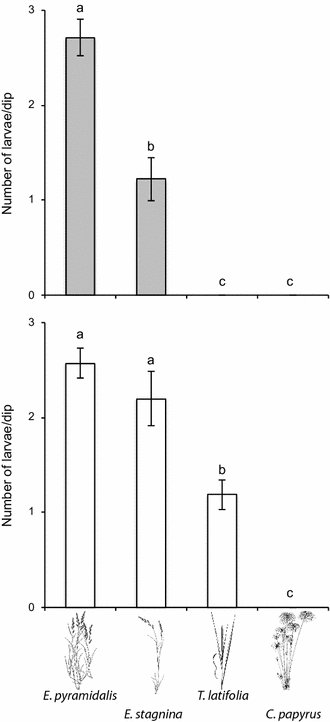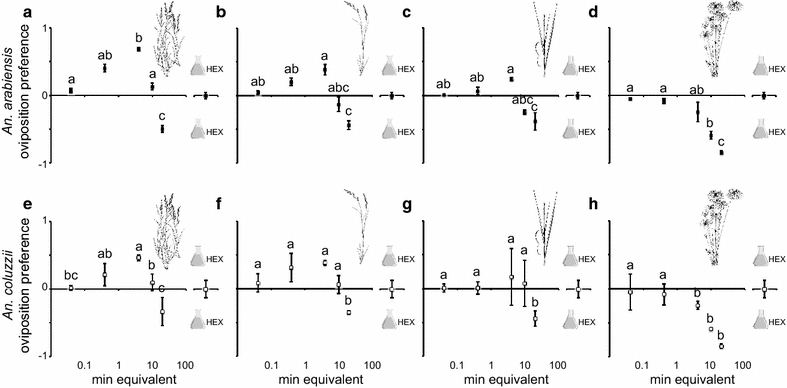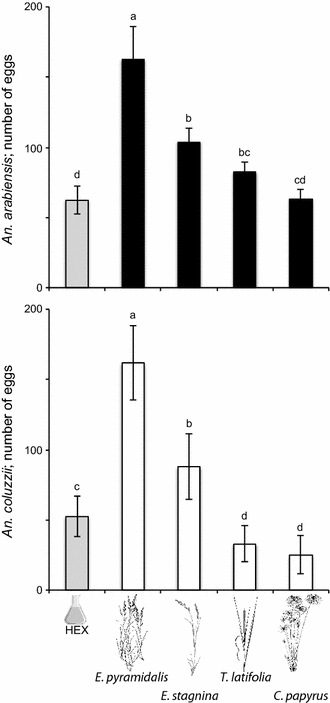The role of grass volatiles on oviposition site selection by Anopheles arabiensis and Anopheles coluzzii
- PMID: 28173804
- PMCID: PMC5297170
- DOI: 10.1186/s12936-017-1717-z
The role of grass volatiles on oviposition site selection by Anopheles arabiensis and Anopheles coluzzii
Abstract
Background: The reproductive success and population dynamics, of Anopheles malaria mosquitoes is strongly influenced by the oviposition site selection of gravid females. Mosquitoes select oviposition sites at different spatial scales, starting with selecting a habitat in which to search. This study utilizes the association of larval abundance in the field with natural breeding habitats, dominated by various types of wild grasses, as a proxy for oviposition site selection by gravid mosquitoes. Moreover, the role of olfactory cues emanating from these habitats in the attraction and oviposition stimulation of females was analysed.
Methods: The density of Anopheles larvae in breeding sites associated with Echinochloa pyramidalis, Echinochloa stagnina, Typha latifolia and Cyperus papyrus, was sampled and the larvae identified to species level. Headspace volatile extracts of the grasses were collected and used to assess behavioural attraction and oviposition stimulation of gravid Anopheles arabiensis and Anopheles coluzzii mosquitoes in wind tunnel and two-choice oviposition assays, respectively. The ability of the mosquitoes to differentiate among the grass volatile extracts was tested in multi-choice tent assays.
Results: Anopheles arabiensis larvae were the most abundant species found in the various grass-associated habitats. The larval densities described a hierarchical distribution, with Poaceae (Echinochloa pyramidalis and Echinochloa stagnina)-associated habitat sites demonstrating higher densities than that of Typha-associated sites, and where larvae were absent from Cyperus-associated sites. This hierarchy was maintained by gravid An. arabiensis and An. coluzzii mosquitoes in attraction, oviposition and multi-choice assays to grass volatile extracts.
Conclusions: The demonstrated hierarchical preference of gravid An. coluzzii and An. arabiensis for grass volatiles indicates that vegetation cues associated with larval habitats are instrumental in the oviposition site choice of the malaria mosquitoes. Identifying volatile cues from grasses that modulate gravid malaria mosquito behaviours has distinct potential for the development of tools to be used in future monitoring and control methods.
Keywords: Anopheles arabiensis; Anopheles coluzzii; Attraction; Habitat; Olfaction; Oviposition; Selection.
Figures




Similar articles
-
A(maize)ing attraction: gravid Anopheles arabiensis are attracted and oviposit in response to maize pollen odours.Malar J. 2017 Jan 23;16(1):39. doi: 10.1186/s12936-016-1656-0. Malar J. 2017. PMID: 28114992 Free PMC article.
-
Using sibship reconstructions to understand the relationship between larval habitat productivity and oviposition behaviour in Kenyan Anopheles arabiensis.Malar J. 2019 Aug 23;18(1):286. doi: 10.1186/s12936-019-2917-5. Malar J. 2019. PMID: 31443645 Free PMC article.
-
Grass Pollen Affects Survival and Development of Larval Anopheles arabiensis (Diptera: Culicidae).J Insect Sci. 2017 Sep 1;17(5):93. doi: 10.1093/jisesa/iex067. J Insect Sci. 2017. PMID: 28922900 Free PMC article.
-
Mechanisms of Plasmodium-Enhanced Attraction of Mosquito Vectors.Trends Parasitol. 2017 Dec;33(12):961-973. doi: 10.1016/j.pt.2017.08.010. Epub 2017 Sep 21. Trends Parasitol. 2017. PMID: 28942108 Review.
-
Olfaction in Anopheles mosquitoes.Chem Senses. 2021 Jan 1;46:bjab021. doi: 10.1093/chemse/bjab021. Chem Senses. 2021. PMID: 33885760 Free PMC article. Review.
Cited by
-
Controlling mosquitoes with semiochemicals: a review.Parasit Vectors. 2020 Feb 17;13(1):80. doi: 10.1186/s13071-020-3960-3. Parasit Vectors. 2020. PMID: 32066499 Free PMC article. Review.
-
Insect chemical ecology: chemically mediated interactions and novel applications in agriculture.Arthropod Plant Interact. 2020;14(6):671-684. doi: 10.1007/s11829-020-09791-4. Epub 2020 Nov 9. Arthropod Plant Interact. 2020. PMID: 33193908 Free PMC article.
-
Warmer temperature accelerates reproductive senescence in mosquitoes.Front Physiol. 2025 Jul 2;16:1610310. doi: 10.3389/fphys.2025.1610310. eCollection 2025. Front Physiol. 2025. PMID: 40671714 Free PMC article.
-
Associations between Dengue Incidence, Ecological Factors, and Anthropogenic Factors in Singapore.Viruses. 2023 Sep 13;15(9):1917. doi: 10.3390/v15091917. Viruses. 2023. PMID: 37766323 Free PMC article.
-
Odour-mediated oviposition site selection in Aedes aegypti depends on aquatic stage and density.Parasit Vectors. 2023 Aug 4;16(1):264. doi: 10.1186/s13071-023-05867-1. Parasit Vectors. 2023. PMID: 37542293 Free PMC article.
References
-
- Hambäck PA, Björkman M, Rämert B, Hopkins RJ. Scale-dependent responses in cabbage herbivores affect attack rates in spatially heterogeneous systems. Basic Appl Ecol. 2009;10:228–236. doi: 10.1016/j.baae.2008.06.004. - DOI
-
- Raffa KF, Andersson MN, Schlyter F. Host selection by bark beetles: playing the odds in a high-stakes game. Adv Insect Physiol. 2016;50:1–74. doi: 10.1016/bs.aiip.2016.02.001. - DOI
-
- Webster B, Cardé RT. Use of habitat odour by host-seeking insects. Biol Rev. 2016 - PubMed
Publication types
MeSH terms
Substances
LinkOut - more resources
Full Text Sources
Other Literature Sources

